2000 AUDI ALLROAD seats
[x] Cancel search: seatsPage 46 of 306
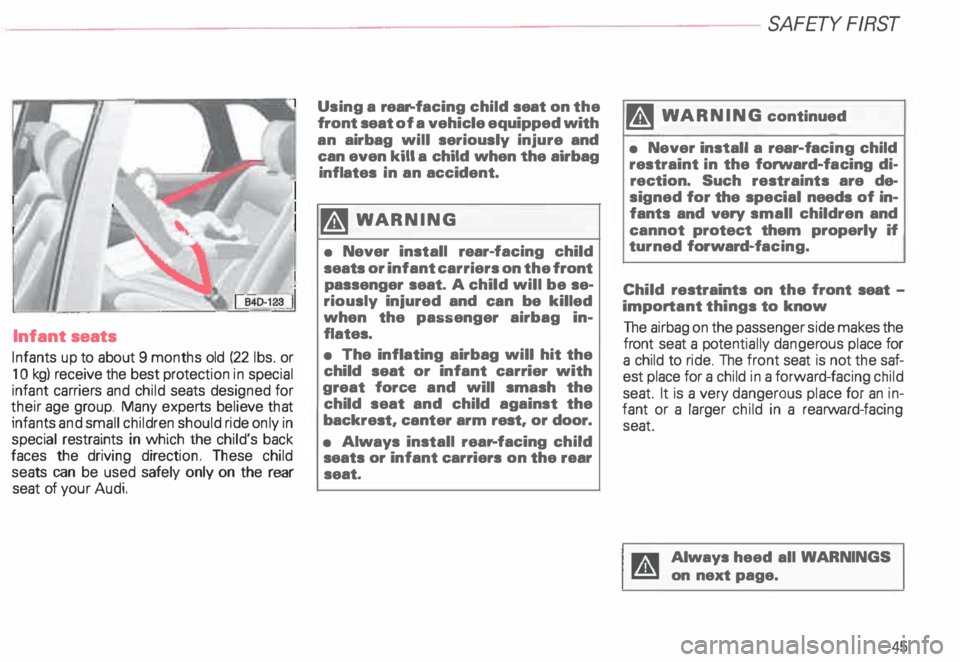
Infant
seats
Infants up to about 9 months old (22 lbs. or
1 0 kg) receive the best protection in special
infant carriers and child seats designed for
their age group. Many experts believe that
infants and small children should ride only in
special restraints in which the child's back
faces the driving direction. These child
seats can be used safely only on the rear
seat of your Audi. Using
a rear-fa cing child seat on the
front seat of a vehicle equipped with
an airbag will seriously injure and
can even kill a child when the airbag
inflates in an accident.
� WARNING
• Never install rear-facing child
seats or infant carriers on the front
passenger seat. A child will be se
riously iniured and can be killed
when the passenger airbag in
flates.
• The inflating airbag will hit the
child seat or infant carrier with
great force and will smash the
child seat and child against the
backrest, canter arm rest, or door.
• Always install rear--facing child
seats or infant carriers on the rear
seat. SA
FETY FIRST
ftl WARNING continued
• Never install a rear-fac ing child
restraint in the forward-fa cing di
rection. Such restraints are de
signed for the special needs of in
fants and very small children and
cannot protect them properly if
turned forward-fa cing.
Child restraints on the front seat -
important things to know
The airbag on the passenger side makes the
front seat a potentially dangerous place for
a child to ride. The front seat is not the saf
est place for a child in a forward-facing child
seat. It is a very dangerous place for an in
fant or a larger child in a rearward-facing
seat.
Always heed all WARNINGS
on next page.
45
Page 48 of 306
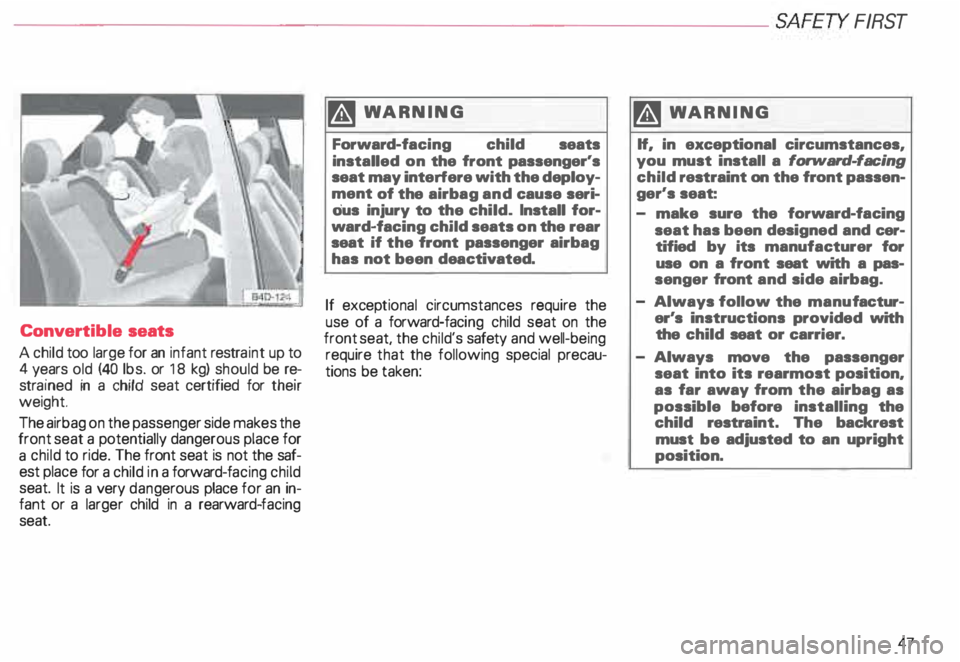
--------------------------SAFETY FIRST
Converti
ble seats
A child too large for an infant restraint up to
4 years old (40 lbs. or 18 kg) should be re
stra ined in a child seat certified for their
weight.
The airbag on the passenger side makes the
front seat a potentially dangerous place for
a child to ride. The front seat is not the saf
est place for a child in a forward-f acing child
seat. It is a very dangerous place for an in
fant or a larger child in a rearward-facing
seat. m
WARNING
Forward-fa cing
child seats
installed on the front passenger's
seat may interfere with the deploy
ment of the airbag and cause seri
ous injury to the child. Install for
ward·fac ing child seats on the rear
seat if the front passenger airbag
has not been deactivated.
If excep tional circumstances require the
use of a forward-fac ing child seat on the
front seat. the child's safety and well-b eing
require that the following special precau
tions be taken: �W
ARNING
If, in exceptional circumstances,
you must install a forward-facing
child restraint on the front passen
ger's seat:
make sure the forward-facing
seat has been designed and cer
tified by its manufacturer for
use on a front seat with a pas
senger front and side airbag.
Always follow the manuf actur
er's instructions provided with
the child seat or carrier.
Always move the passenger
seat into its rearmost position,
as far away from the airbag as
possible before installing the
child restraint. The backrest
must be adjusted to an upright
position.
47
Page 49 of 306
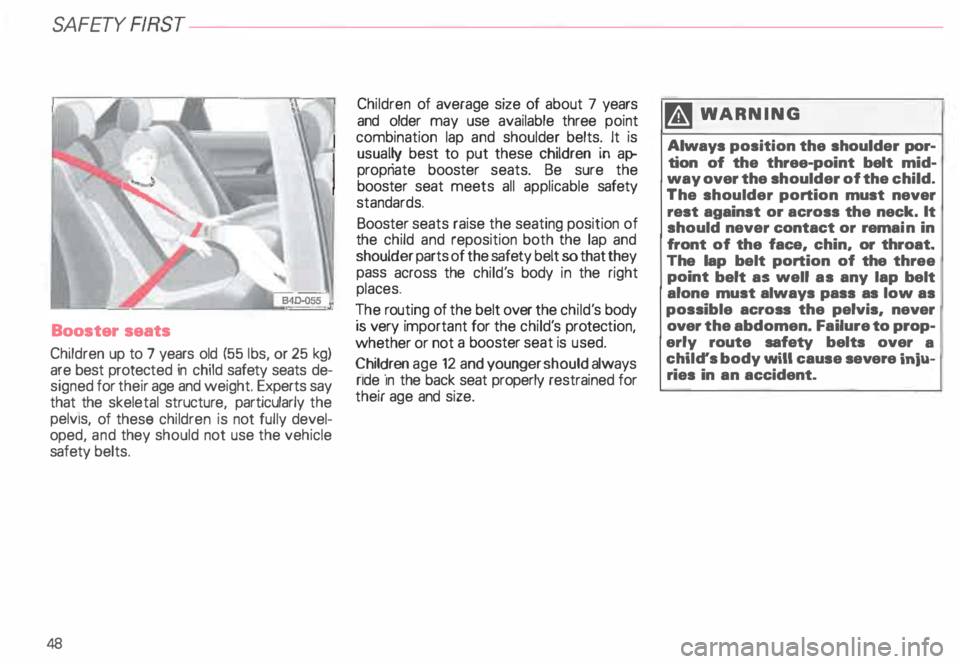
SA
FETY FIRST--
Booster seats
Children up to 7 years old (55 1bs, or 25 kg)
are best protect ed in child safety seats de
signed for their age and weight. Experts say
that the skeletal structure, particularly the
pelvis, of these children is not fully devel
oped, and they should not use the vehicle
safety belts.
48 Children
of average size of about 7 years
and older may use available three point
combination lap and shoulder belts. It is
usual �y best to put these children in ap
propnate booster seats. Be sure the
booster seat meets all applicable safety
standards.
Booster seats raise the seating position of
the child and reposition both the lap and
shoulder parts of the safety belt so that they
pass across the child' s body in the right
places.
} he rou.ting of the belt over the child' s body
IS very Important for the child' s protec tion,
whether or not a booster seat is used.
Chil �ren age 12 and younger should always
nde 1n the back seat properly restrained for
their age and size. �W
ARNING
� lways position the shoulder por
tion of the three-point belt mid
way over the shoulder of the child.
The shoulder portion must never
rest against or across the neck. It
should never contact or rema in in
front of the face, chin, or throat.
The lap belt portion of the three
point belt as well as any lap belt
alone must always pass as low as
possible across the pelvis, never
over the abdomen. Failure to prop
erly route safety belts over a
chil d's body will cause severe iniu
ries in an accident.
Page 51 of 306
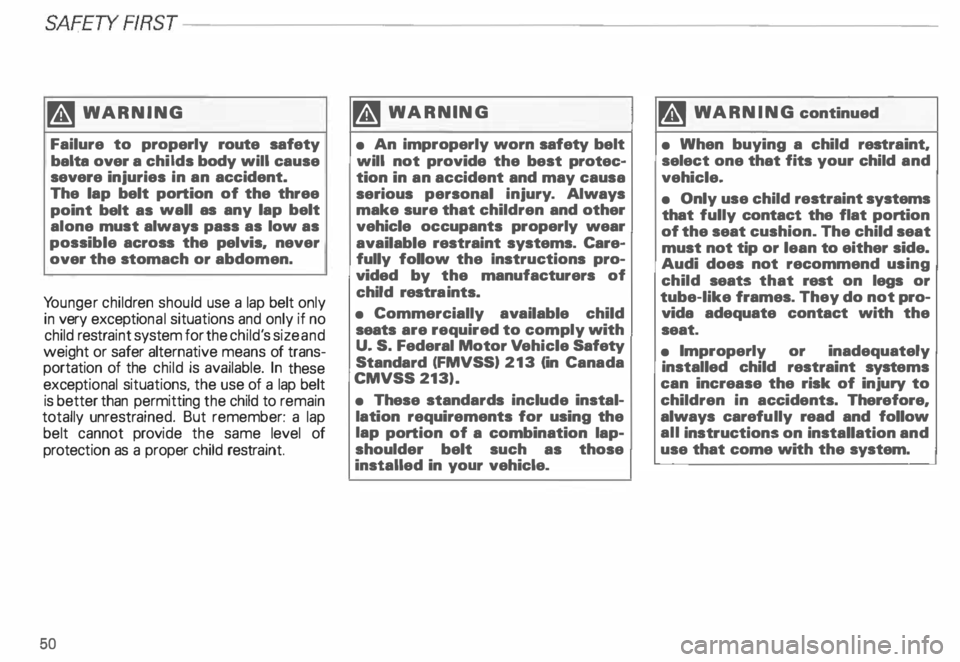
SAFETYRRST-----------------------------------------------------
�W ARNING
Failure to properly route safety
balta over a childs body will cause
severe injuries in an accident.
The lap belt portion of the three
point belt as wall as any lap belt
alone must always pass as low as
possible across the pelvis, never
over the stomach or abdomen.
Yo unger children should use a lap belt only
in very exceptio nal situations and only if no
child restraint system for the child' s size and
weight or safer alternative means of trans
portation of the child is available. In these
excep tional situations, the use of a lap belt
is better than permitting the child to remain
totally unrestrained. But remember: a lap
belt cannot provide the same level of
protect ion as a proper child restra int.
50 �W
ARNING
• An improperly worn safety belt
will not provide the best protec
tion in an accident and may causa
serious personal injury. Always
make sure that children and other
vehicle occupants properly wear
available restraint systems. Care
fully follow the Instructions pro
vided by the manufacturers of
child restra ints.
• Commercially available child
seats are required to comply with
U. S. Federal Motor Vehicle Safety
Standard (FMVSS) 213 (in Canada
CMVSS 213).
• These standards include instal
lation requirements for using the
lap portion of a combination lap
shoulder belt such as those
installed in your vehicle. fA,
WARNING continued
• When buying a child restraint,
select one that fits your child and
vehicle.
• Only use child restraint systems
that fully contact the flat portion
of the seat cushion. The child seat
must not tip or lean to either side.
Audi does not recommend using
child seats that rest on legs or
tube-like frames. They do not pro
vida adequate contact with the
seat.
• Improperly or inadequately
installed child restraint systems
can increase the risk of injury to
children in accidents. Therefore,
always carefully read and follow
all instructions on installation and
use that come with the system.
Page 52 of 306
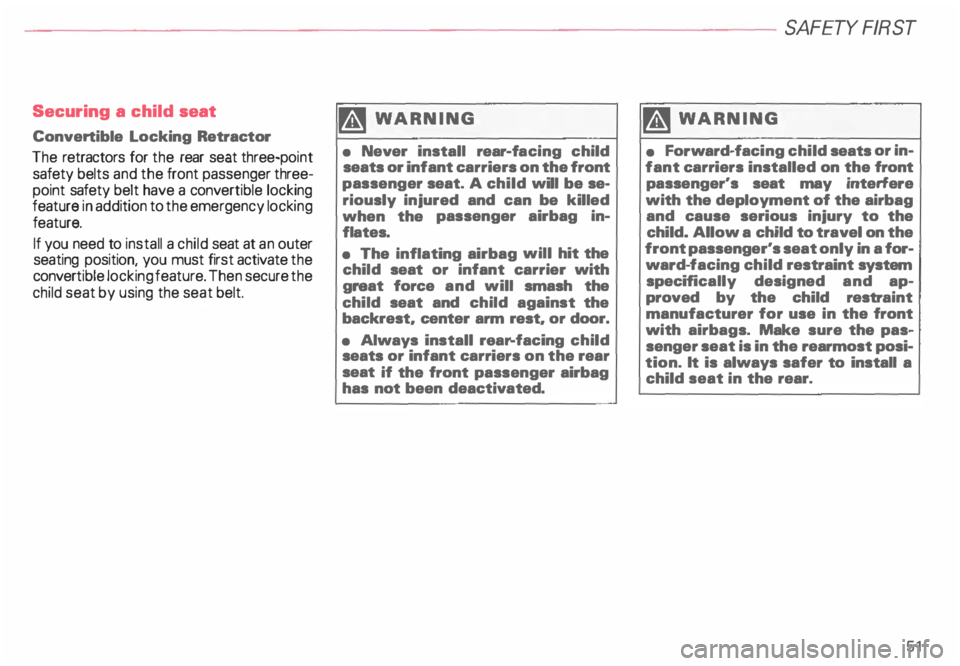
Securing a child seat
Convertible Locking Retractor
The retractors for the rear seat three-po int
safety belts and the front passenger three
point safety belt have a conver tible locking
feature in addition to the emergency locking
feature.
If you need to install a child seat at an outer
seating position, you must first activate the
conver tible locking feature. Then secure the
child seat by using the seat belt. �W
ARNING
• Never install rear-facing child
seats or infant carriers on the front
passenger seat. A child will be se
riously injured and can be killed
when the passenger airbag in
flates.
• The inflating airbag will hit the
child seat or infant carrier with
great force and will smash the
child seat and child against the
backrest. center arm rest. or door.
• Always install rear-facing child
seats or infant carriers on the rear
seat if the front passenger airbag
has not been deactivated. SA
FETY FIRST
�W ARNING
• Forward-fa cing child seats or in
fant carriers installed on the front
passenger's seat may interfere
with the deployment of the airbag
and cause serious injury to the
child. Allow a child to travel on the
front passenger's seat only in a for
ward- facing child restraint system
specif ically designed and ap
proved by the child restraint
manufacturer for use in the front
with airbags. Make sure the pas
senger seat is in the rearmost posi
tion. It is always safer to install a
child seat in the rear.
51
Page 54 of 306
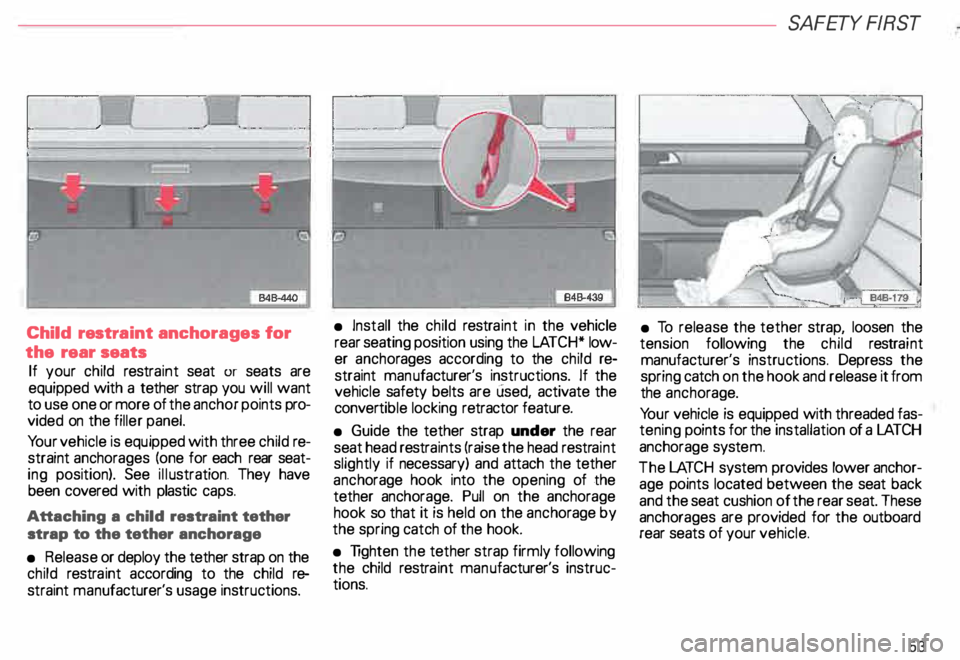
Child
restra int anchorages for
the rear seats
If your child restraint seat or seats are
equipped with a tether strap you will want
to use one or more of the anchor points pro
vided on the filler panel.
Yo ur vehicle is equipped with three child re
straint anchorages (one for each rear seat
ing position). See illustration. They have
been covered with plastic caps.
Attaching a child restraint tether
strap to the tether anchorage
• Release or deploy the tether strap on the
child restraint according to the child re
straint manufacturer's usage instructions. •
Install the child restra int in the vehicle
rear seating position using the LATCH* low
er ancho rages according to the child re
straint manufacturer's instructions. If the
vehicle safety belts are used, activate the
conver tible locking retractor feature.
• Guide the tether strap under the rear
seat head restraints (raise the head restraint
slightly if necessary) and attach the tether
anch orage hook into the opening of the
tether anchorage. Pull on the anchorage
hook so that it is held on the anch orage by
the spring catch of the hook.
• Tighten the tether strap firmly following
the child restra int man ufacturer's instruc
tions. SA
FETY FIRST
• To release the tether strap, loosen the
tension following the child restraint
manufacturer's instructions. Depress the
spring catch on the hook and release it from
the anch orage.
Yo ur vehicle is equipped with threaded fas
tening points for the installation of a LA TCH
anchorage system.
The LATCH system provides lower anchor
age points located between the seat back
and the seat cushion of the rear seat. These
anchorages are provided for the outboard
rear seats of your vehicle.
53
Page 55 of 306
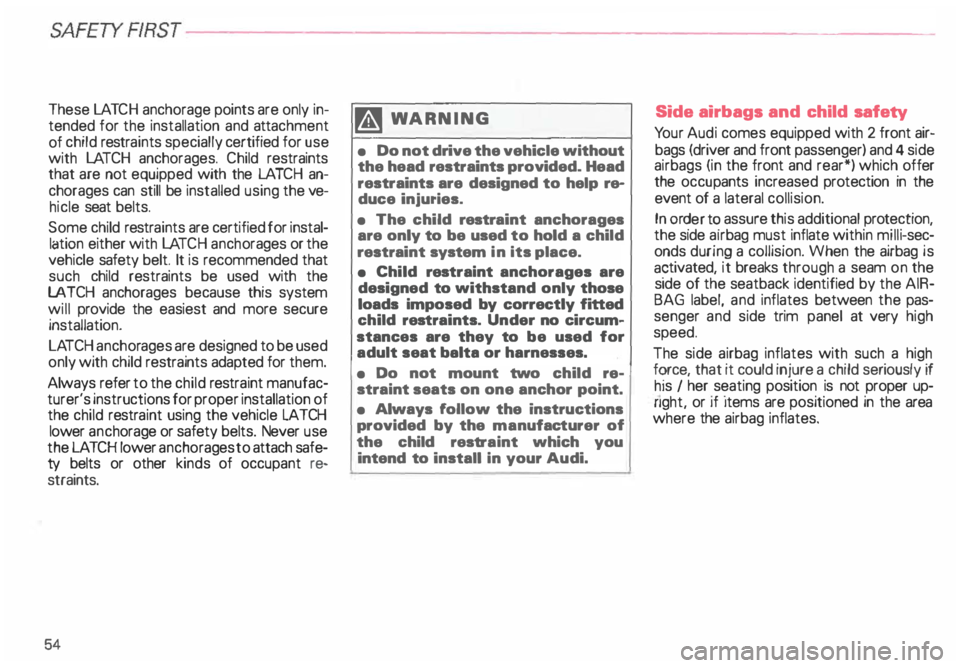
SAFETYRRST----------------------------------------------------
These LATCH anchorage points are only in
tended for the installation and attachment
of child restra ints specially certified for use
with LATCH anchorages. Child restraints
that are not equipped with the LATC H an
chorages can still be installed using the ve
hicle seat belts.
Some child restra ints are certified for instal
lation either with LATCH ancho rages or the
vehicle safety belt. It is recommended that
such child restraints be used with the
LATCH anchorages because this system
will provide the easiest and more secure
installation.
LA TCH anchor ages are designed to be used
only with child restraints adapted for them.
Always refer to the child restra int manufac
turer's instructions for proper installation of
the child restra int using the vehicle LATCH
lower anchorage or safety belts. Never use
the LATC H lower ancho rages to attach safe
ty belts or other kinds of occupant re
straints.
54 �W
ARNING
• Do not drive the vehicle without
the head restraints provided. Head
restraints are designed to help re
duce injuries.
• The child restraint anchorages
are only to be used to hold a child
restra int system in its place.
• Child restraint anchorages are
designed to withstand only those
loads imposed by correctly fitted
child restraints. Under no circum
stances are they to be used for
adult seat balta or harnesses.
• Do not mount two child re
straint seats on one anchor point.
• Always follow the instructions
provided by the manufacturer of
the child restraint which you
intend to install in your Audi. Side
airbags and child safety
Yo ur Audi comes equipped with 2 front air
bags (driver and front passenger) and 4 side
airbags (in the front and rear*) which offer
the occu pants increased protection in the
event of a lateral collision.
In or�er t� assure this additional protection,
the s1de a1rbag must inflate within milli-sec
onds during a collision. When the airbag is
a ?tivated, it breaks through a seam on the
s1de of the seatback identified by the AIR
BAG label, and inflates between the pas
senger and side trim panel at very high
speed.
The side airbag inflates with such a high
f ? rce, that it could injure a child seriously if
h1s I her seating position is not proper up
nght, or 1f 1tems are positioned in the area
where the airbag inflates.
Page 76 of 306
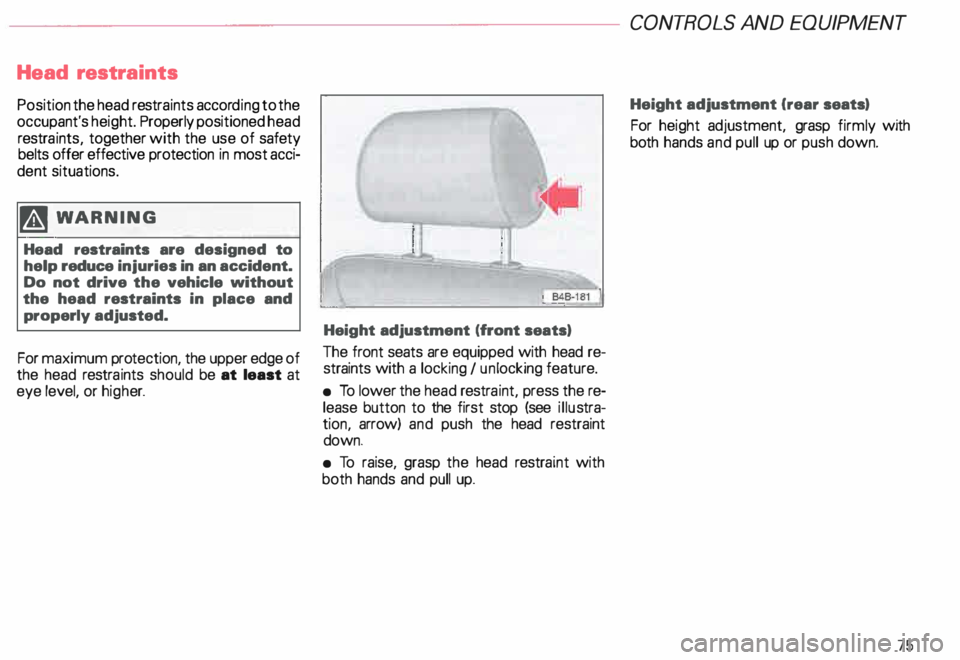
Head
restra ints
Position the head restra ints accor ding to the
occupant's height. Properly positioned head
restra ints, together with the use of safety
belts offer effective protection in most acci
dent situations.
g WARNING
Head restraints are designed to
help reduce injuries in an accident.
Do not drive the vehicle without
the head restraints in place and
properly adjusted.
For maximum protection, the upper edge of
the head restra ints should be at least at
eye level, or high er. ' 848·181
Height adjustment (front seats)
The front seats are equipped with head re
straints with a locking I un locking feature.
• To lower the head restra int, press the re
lease button to the first stop (see illustra
tion, arrow) and push the head restraint
down.
• To raise, grasp the head restraint with
both hands and pull up. CONT
ROLS AND EQUIPMEN T
Height adjustment Crear seats)
For height adjustment, grasp firmly with
both hands and pull up or push down.
75